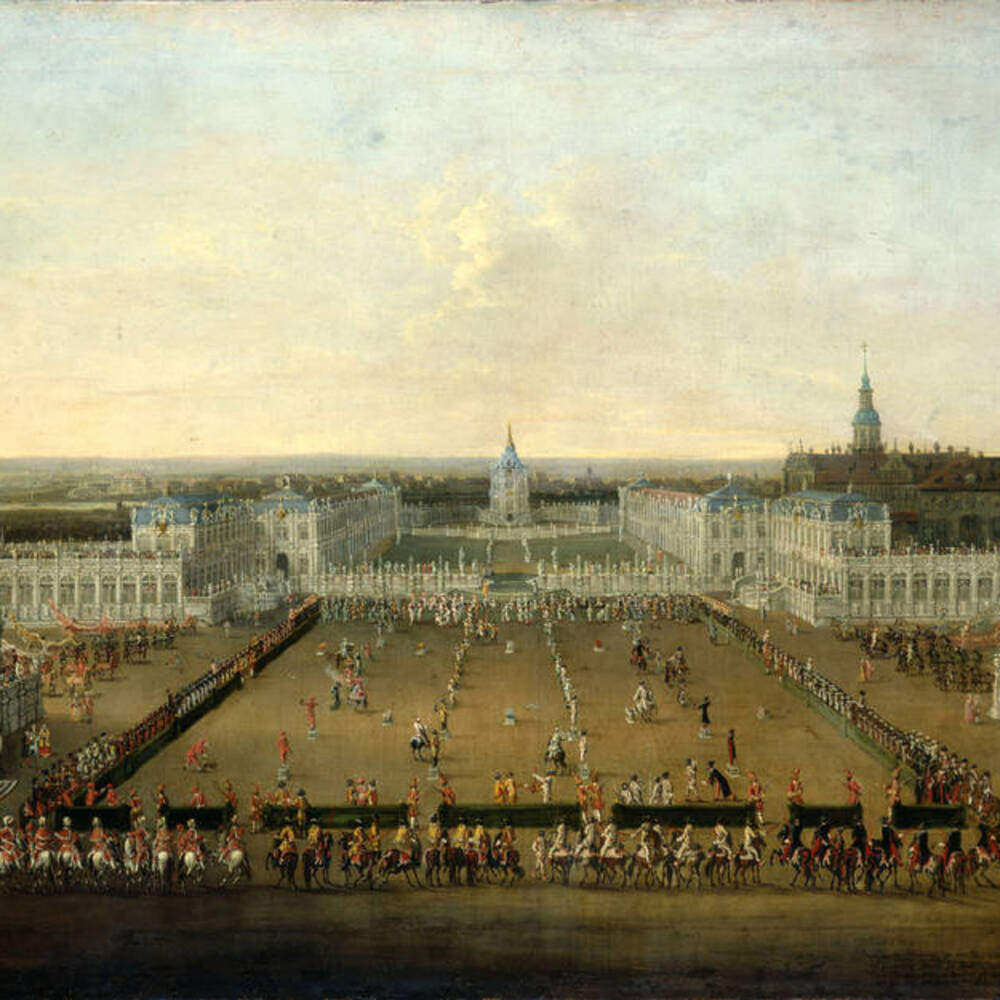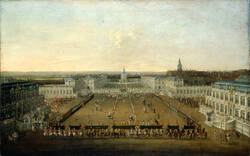In these two paintings, Thiele combines completed sections of the Dresden Zwinger with planned parts. For example, he depicts a palace building – which was never constructed – extending to the north, on the site where the Semper Gallery was built in 1855. The Zwinger provided a magnificent setting for the festive procession and horse races held at the end of the Carnival celebrations in February 1722, in which August the Strong took part. Thiele also embeds buildings and the city into the landscape visible in the background.
Further Media



Just before this scene, the gentlemen accompanied their ladies to the pavilions where they will have a magnificent view of the event. A host of riders and soldiers then took up their positions around the field where the competition is held. They too, just like those watching, are part of the spectacle. Now, the race begins. On horseback and on foot, the gentlemen join in a relay race involving a number of games of skill. In the end, the winner is the ‘Royal Prince’.
Although this spectacle seems very much like a game, it followed the clear and strict hierarchies at court. August the Strong led the Scaramuzi group. The Harlequini group was headed by the Duke of Weißenfels, while the Pantaloni were under Electoral Prince Friedrich August who, here in the Zwinger three years previously, had celebrated his wedding to Maria Josepha, Archduchess of Austria.
Then, much of the Zwinger complex had already been completed. It still lacked the connection to the north where today you find the Picture Gallery and Theaterplatz square. In the centre of this vista, Johann Alexander Thiele sets a large, slightly raised courtyard enclosed by two long buildings and ending in an arcade leading to the River Elbe – just as originally intended by the architect Matthäus Daniel Pöppelmann. However, that section was never built as planned. Only around 130 years later was the provisional solution replaced by the Sempergalerie, which you are in at present.
The painting of the festive procession in the Zwinger is certainly impressive – but have you noticed how Thiele’s standpoint is far higher than would have been possible in reality? For this perspective, he would have been looking down from a point above the pavilion – later the Glockenspielpavillon – but then just a provisional structure. We are looking over the events in the race to the Wallpavillon. In the background, the Elbe valley curves away towards Meissen. The foreground is framed by deep shadow and the dark silhouettes of two buildings. Today, the building to the left houses the Porcelain Collection, and the one to the right is the Germany Gallery in the Gemäldegalerie – the Picture Gallery.
This scene’s strict linear perspective also holds a tribute to August the Strong, who had the Zwinger built. The lines of perspective lead to one central point – the large sculpture on the Wallpavillon. Although Balthasar Permoser’s sculpture depicts Hercules bearing the world on his shoulders, this work clearly alludes to August the Strong, Elector of Saxony and King of Poland. Not only was August nicknamed the Saxon Hercules, but just like other absolute rulers in the baroque period, he saw himself as the very centre of his state.
- Location & Dating
- before 1725
- Material & Technique
- Oil on canvas
- Dimenions
- 106 x 168 cm
- Museum
- Gemäldegalerie Alte Meister
- Inventory number
- Gal.-Nr. 3603